#the surrealist revolution
Explore tagged Tumblr posts
Text

LA RÉVOLUTION SURRÉALISTE COVER OF THE FIRST ISSUE [DEC 1924]
117 notes
·
View notes
Text
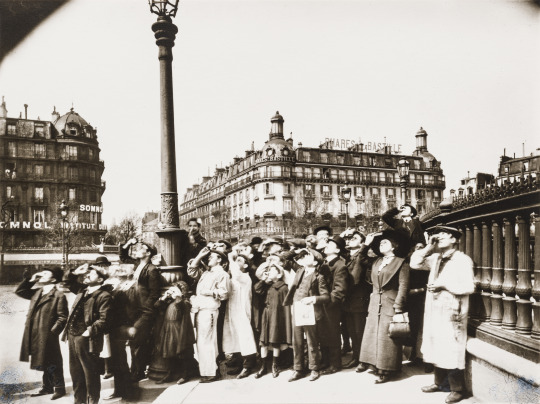
Eugène Atget, Eclipse
From the Blanton Museum’s Art at Home newsletter:
French artist Eugène Atget (1857-1927) focused his lens on the city and people of Paris for nearly four decades, producing more than 8,500 pictures throughout his career. In his photograph Eclipse, a crowd is gathered in Paris’ Place de la Bastille to observe the 1912 solar eclipse. Rather than recording the astronomical event itself, Atget turned his attention to its spectators. Fun fact: Surrealist artist Man Ray bought Atget’s photograph to illustrate the June 1926 cover of La Révolution Surréaliste—a subversive publication that adopted a pseudo-scientific format to explore the irrational nature of existence
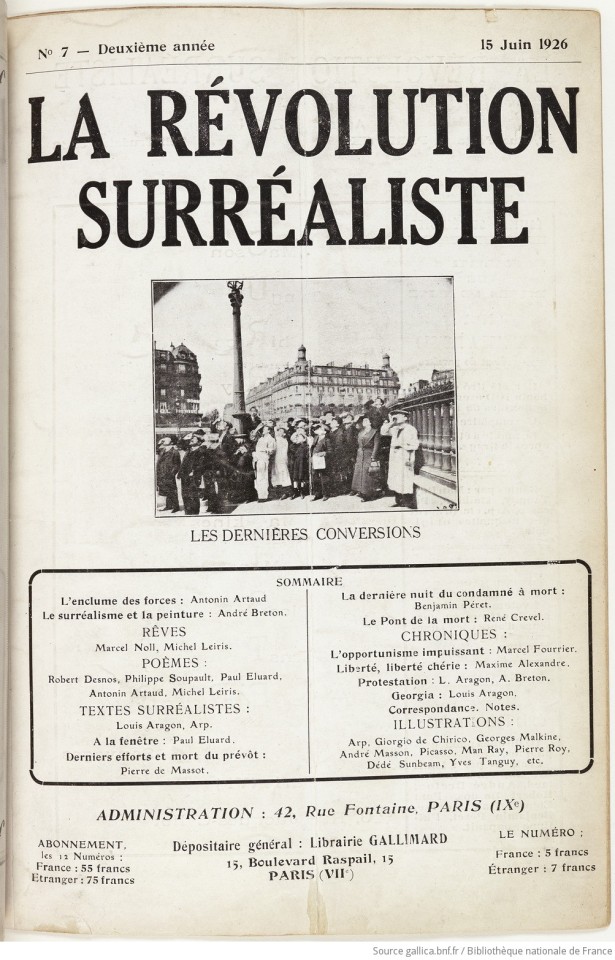
23 notes
·
View notes
Text

(Antonin Artaud, La Révolution surréaliste, 1st january 1925)
In Libro Veritas :: @InlibroV
"And you, lucid madmen ..." Antonin Artaud
3 notes
·
View notes
Text
A list of all the books mentioned in Peter Doherty's journals (and in some interviews/lyrics, too)
Because I just made this list in answer to someone's question on a facebook group, I thought I may as well post it here.
-The Picture of Dorian Gray/The Ballad Of Reading Gaol/Salome/The Happy Prince/The Duchess of Padua, all by Oscar Wilde -The Thief's Journal/Our Lady Of The Flowers/Miracle Of The Rose, all by Jean Genet -A Diamond Guitar by Truman Capote -Mixed Essays by Matthew Arnold -Venus In Furs by Leopold Sacher-Masoch -The Ministry Of Fear by Graham Greene -Brighton Rock by Graham Green -A Season in Hell by Arthur Rimbaud -The Street Of Crocodiles (aka Cinnamon Shops) by Bruno Schulz -Opium: The Diary Of His Cure by Jean Cocteau -The Lost Weekend by Charles Jackson -Howl by Allen Ginsberg -Women In Love by DH Lawrence -The Tempest by William Shakespeare -Trilby by George du Maurier -The Vision Of Jean Genet by Richard Coe -"Literature And The Crisis" by Isaiah Berlin -Le Cid by Pierre Corneille -The Paris Peasant by Louis Aragon -Junky by William S Burroughs -Absolute Beginners by Colin MacInnes -Futz by Rochelle Owens -They Shoot Horses Don't They? by Horace McCoy -"An Inquiry On Love" by La revolution surrealiste magazine -Idea by Michael Drayton -"The Nymph's Reply to The Shepherd" by Sir Walter Raleigh -Hamlet by William Shakespeare -The Silver Shilling/The Old Church Bell/The Snail And The Rose Tree all by Hans Christian Andersen -120 Days Of Sodom by Marquis de Sade -Letters To A Young Poet by Rainer Maria Rilke -Poetics Of Space by Gaston Bachelard -In Favor Of The Sensitive Man and Other Essays by Anais Nin -La Batarde by Violette LeDuc -Lolita by Vladimir Nabokov -Intimate Journals by Charles Baudelaire -Juno And The Paycock by Sean O'Casey -England Is Mine by Michael Bracewell -"The Prelude" by William Wordsworth -Noise: The Political Economy of Music by Jacques Atalli -"Elm" by Sylvia Plath -"I am pleased with my sight..." by Rumi -She Stoops To Conquer by Oliver Goldsmith -Amphitryon by John Dryden -Oscar Wilde by Richard Ellman -The Song Of The South by James Rennell Rodd -In Her Praise by Robert Graves -"For That He Looked Not Upon Her" by George Gascoigne -"Order And Disorder" by Lucy Hutchinson -Man Crazy by Joyce Carol Oates -A Pictorial History Of Sex In The Movies by Jeremy Pascall and Clyde Jeavons -Anarchy State & Utopia by Robert Nozick -"Limbo" by Samuel Taylor Coleridge -Men In Love: Masculinity and Sexuality in the Eighteenth Century by George Haggerty
[arbitrary line break because tumble hates lists apparently]
-Crime And Punishment by Fyodor Dostoevsky -Innocent When You Dream: the Tom Waits Reader -"Identity Card" by Mahmoud Darwish -Ulysses by James Joyce -The Four Quartets poems by TS Eliot -Julius Caesar by William Shakespeare -A'Rebours/Against The Grain by Joris-Karl Huysmans -Prisoner Of Love by Jean Genet -Down And Out In Paris And London by George Orwell -The Man With The Golden Arm by Nelson Algren -Revolutionary Road by Richard Yates -"Epitaph To A Dog" by Lord Byron -Cocaine Nights by JG Ballard -"Not By Bread Alone" by James Terry White -Anecdotes Of The Late Samuel Johnson by Hester Thrale -"The Owl And The Pussycat" by Edward Lear -"Chevaux de bois" by Paul Verlaine -A Strong Song Tows Us: The Life of Basil Bunting by Richard Burton -Don Quixote by Miguel de Cervantes -The Divine Comedy by Dante Alighieri -The Jungle Book by Rudyard Kipling -The Man Who Would Be King by Rudyard Kipling -Ask The Dust by John Frante -On The Trans-Siberian Railways by Blaise Cendrars -The 39 Steps by John Buchan -The Overcoat by Nikolai Gogol -The Government Inspector by Nikolai Gogol -The Iliad by Homer -Heart Of Darkness by Joseph Conrad -The Volunteer by Shane O'Doherty -Twenty Love Poems and A Song Of Despair by Pablo Neruda -"May Banners" by Arthur Rimbaud -Literary Outlaw: The life and times of William S Burroughs by Ted Morgan -The Penguin Dorothy Parker -Smoke by William Faulkner -Hero And Leander by Christopher Marlowe -My Lady Nicotine by JM Barrie -All I Ever Wrote by Ronnie Barker -The Libertine by Stephen Jeffreys -On Murder Considered As One Of The Fine Arts by Thomas de Quincey -The Void Ratio by Shane Levene and Karolina Urbaniak -The Remains Of The Day by Kazuo Ishiguro -Dead Fingers Talk by William S Burroughs -The England's Dreaming Tapes by Jon Savage -London Underworld by Henry Mayhew
113 notes
·
View notes
Note
havent watched utena and all i really know is theres something about duels and a revolution in it? what exactly should someone go in expecting? is this an anime thats like going to leave a viewer wanting to like really think about everything and take it slow is it going to be emotional ? what kind of headspace is it going to inspire ?
absurdist, surrealist, deeply symbolic and allegorical, meta as shit and progressively 4th wall breaking the further in you go. 90% of the time the show refuses to explain itself or its symbols, it just uses them and lets the audience scout for connections and meaning on its own. if you were the sort of kid that loved highschool literature class this is THEE anime for you. singlehandedly changed the vocabulary i use to discuss themes around eternity, patriarchal subjugation, grief, cycles of violence, growing up and nostalgia.
if you want a more standard plot description, it's about this goofy, fire-willed tomboy getting caught in a mysterious sword dueling tournament while protecting one of her schoolmates from her shitty boyfriend. turns out the classmate she saved is the "Rose Bride", a mysterious girl capable of "revolutionizing the world"... and also the prize for winning the tournament! whoever wins her in duel has a right to her hand AND agency AND personhood and has complete power over her. the series follows utena (and thus anthy, ie the rose bride) as she initially refuses to be involved in Any Of That Freak Shit, You People Are Insane but is dragged in further and further out of her growing sympathy and attachment to anthy and the fact that, if she just washes her hands of the matter, it won't stop anthy from continuing to be the rose bride and treated as a tool by the other duelists. and of course, the moral complications and power disparities of complying with such a horrible system, even as you try to fight against it from within.
yes that is a very obvious allegory for patriarchal systems of violence. even if the plot sounds a bit insane, it's that way for a reason. rgu is just the type of story that forfeits logical narrative writing in favor of visual symbolism and allegorical storytelling. it's a story about violence and the societal systems that are upheld by it. it's about the glorification of youth and stasis. it's about eternity. it's about compassion and the willingness to reach out to one another all the same, even when it's easier to succumb to how the world wants things to stay and dismantling the cruelty around you. it's about princes and it's about witches and how very very easy it is so hurt each other, and how compassion is both the hardest and easiest thing in the world, and how it drove a little girl to break the world in two.
also the entire series is free on youtube if you're american. if you're not get a vpn/use a YouTube mirror like newpipe and it should work
54 notes
·
View notes
Text










It’s Feral Friday!
This week we’re diving into zine history.
Zines amplify marginalized voices & stories excluded from conventional publishing, challenge authority, and provide egalitarian channels for creative expression and alternative community building.
Though often dated to the sci-fi fanzines of 1930s, some argue that zine history originated in the context of early printing in the 16th century with Martin Luther’s self-published 95 Theses. Given Luther’s use of vernacular, critiques of established ideologies, and use of pamphleteering to spread his message, we tend to agree! Following suit overseas, the cheaply produced broadsides of the 18th century American Revolution were quickly disseminated to influence public opinion.
In the 1920s artists in Europe produced radical journals and periodicals which spread the ideas of Surrealist and Dada movements and critique of bourgeoise culture. In the 30s sci-fi fanzines provided platforms for fan content and dialogue. The Beat poets produced low-cost mimeographed chapbooks and broadsides in the 40s & 50s, challenging the censorial nature of American society with writing on civil rights, the anti-war movement, environmentalism, and free love.
During the same period the Soviet Union DIY (aka Samizdat) movement, in which Eastern Bloc activists reproduced and distributed state censored publications by hand (often on typewriters), emerged. Xerography became popularly available in the 60s and low-cost offset printing and the electric typewriter were introduced, spurring the rise of underground comix & alternative newspapers.
Punk zines appeared in the 70s, followed by the DIY movement and the indie music scene. In the 80s copy machines became ubiquitous, and in the 90s the Riot Grrrl underground punk movement and rise of third wave feminism produced a slew of new publications.
Because forms of zine production have proliferated in various contexts throughout printing history, even a Western-centric overview was hard to capture succinctly. Stay tuned for more in future posts!
Images:
Dada germanico. Gabriele Mazzota editore, Milan, 1970. Facsimile edition of 1920 original.
Dada germanico.
from Disputatio D. Martini Luther theologi, pro declaratione virtutis indulgentiarum, a bound edition of Martin Luther's 95 Theses. Adam Petri, Basel, 1517.
How industrial unionism was won : the great Flint sit-down strike against General Motors, 1936-1937. Progressive Labor Party, Brooklyn, NY.
Prose contribution to Cuban revolution. Allen Ginsberg. Artists' Workshop Press, Detroit, 1966.
Russian samizdat and photo negatives of unofficial literature in the USSR. Moscow. Wikimedia Commons.
The Bunch's power pak comics. Aline Kominsky-Crumb. Kitchen Sink Enterprises, Princeton, WI, 1979.
Plunger. Alison. Team Plunge, New York, NY. Dec. 1994.
FAT! SO?. Marilyn Wann. San Francisco, CA. no.4 1995.
Angry black-white girl : reflections on my mixed race identity. Nia Diaspora. Publication year unknown (between 2000-2009).
View more Feral Friday posts.
View more posts with zines.
--Ana, Special Collections Graduate Intern
#feral friday#zines#history of zines#labor rights#dada#martin luther#95 theses#riot grrrl#samizdat#underground comix#Aline Kominsky-Crumb#Allen Ginsberg#Nia Diaspora#Nia King#Detroit Artist Workshop Press#dada germanico#feral#feral fridays#Ana#Detroit Artists Workshop#zine culture#Kitchen Sink Press#Marilyn Wann#Plunger#beat generation#Angry Black-White Girl#Power Pak Comics
88 notes
·
View notes
Text
Responding to Lily Orchard on Utena
So I already talked about how Lily Orchard never watched Revolutionary Girl Utena and doesn't understand it on my main blog, and now she's trying to invoke the arguments I've had with other morons who have never watched and don't understand Revolutionary Girl Utena. Discussion beneath the cut!
[Lily's Post]
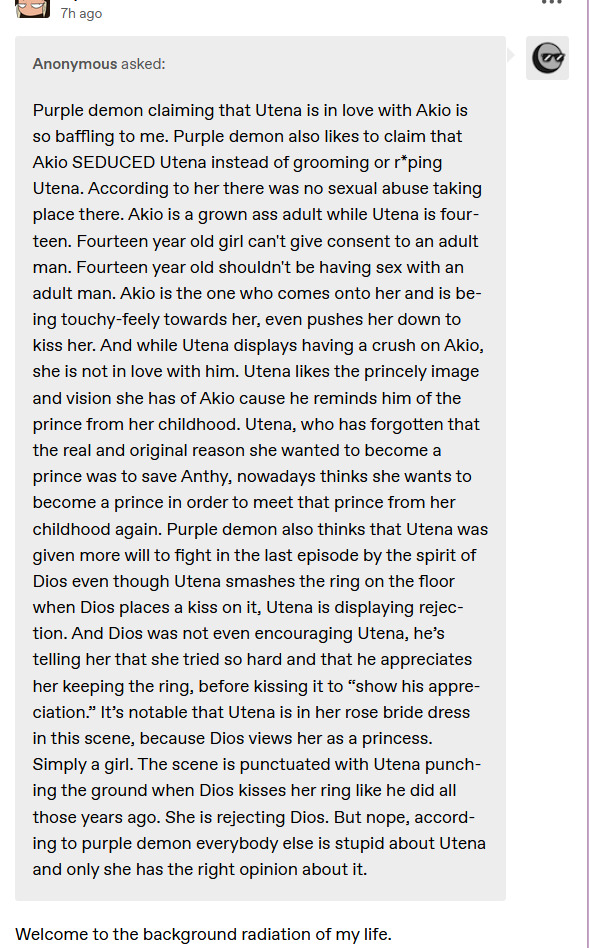
Here Lily and the little zoomers on Twitter who have never engaged with Utena beyond making a tumblr mood board, let me hold your hand through episode 33 The Prince Who Runs Through the Night from my "Let's Watch Utena" livestream from a few months ago. Uploaded unlisted:
youtube
Going "um sweaty she's a minor!!!???" instead of engaging with the actual text just stalls any meaningful discussion about the purpose of this episode within the narrative. Utena is a surrealistic piece that operates entirely on hazy dream logic. Trying to bring in real world ethics outside of the text into Akio's seduction Utena is simply irrelevant to what is being communicated. It would be like stalling every discussion about a revenge plot movie with "but murder is illegal!"
As I said on the stream Akio's seduction of Utena is Faustian. He is the devil pulling her further away from her gender role defiant values and her true purpose of saving Anthy from her eternal suffering, as she was spurred to do by the spirit of Dios. He is also using her because he thinks the Sword of Dios he can draw from her will be the key to opening the seal to the "Power of Revolution". But Akio can never regain the power of the Prince again, as he's a corrupt adult now. The ideal of the Prince that exists in both the hearts of Anthy and Utena.
This is a series you have to take within its own symbolic language. It is not interested in being realistic or straight forward. It's heavily influenced by experimental stage theater. Ikuhara purposefully wanted it to be tonally mismatched to put the audience in the mindset of the world.
On the next point:
I've been into Utena for 28 years. I've read lots of essays on it and have listened to many interpretations of it. I have no idea where this idea that Utena "rejects" Dios is suddenly coming from. I'll reiterate from the debate I had about this on Twitter:
Dios, the actual spirit of the ideal of the Prince, whose spirit she calls down during duels, who has only ever spoken to Utena in the space between life and death, appears here to Utena as the duel song chorus swells with "I exist! I'm here!"
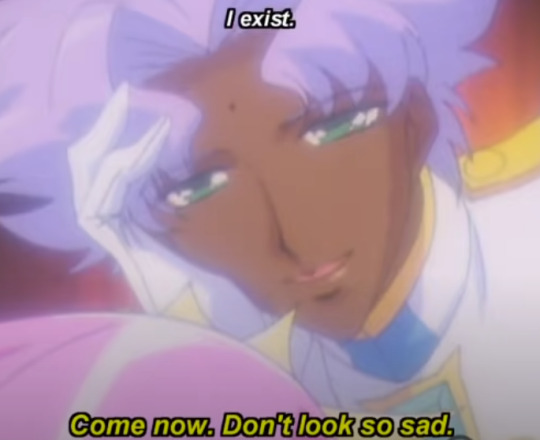
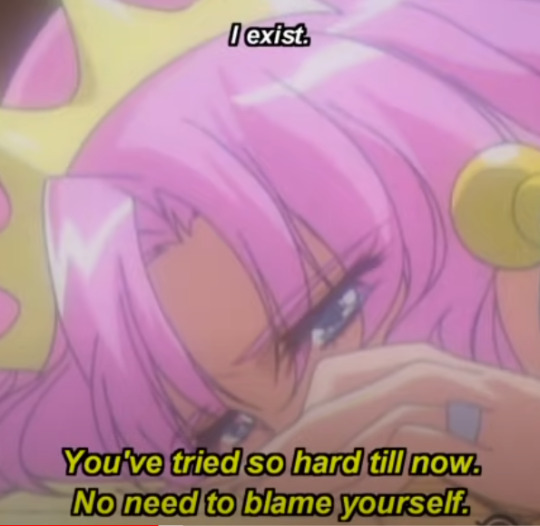
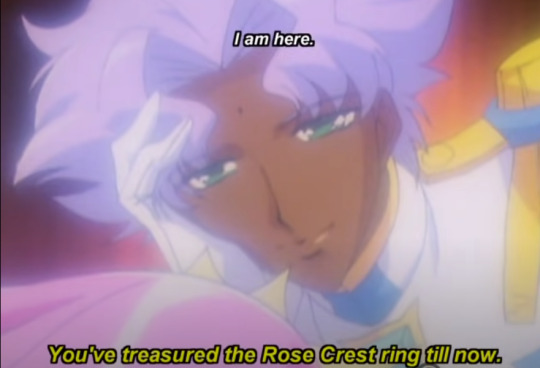
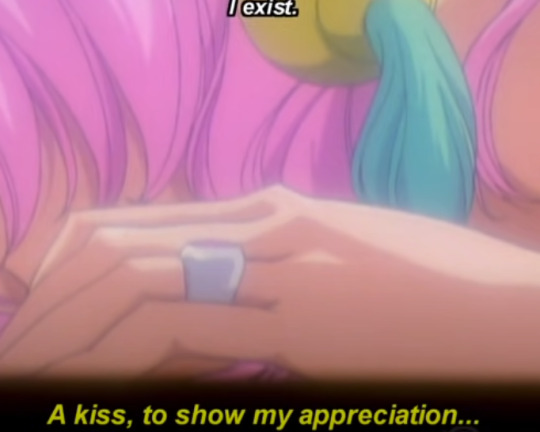
Dios kisses her ring
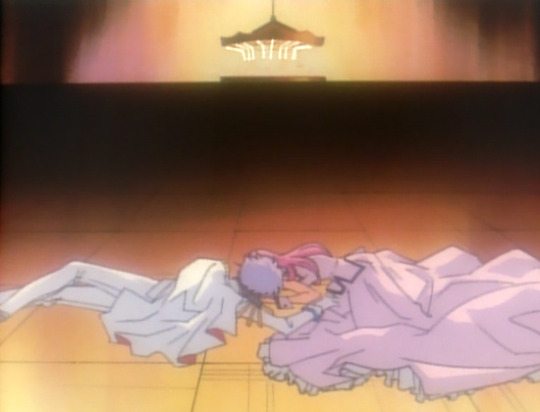
And Utena finds the strength to get back up.
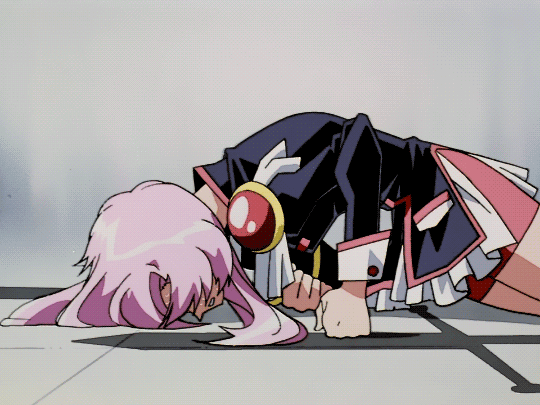
And when Akio is about to drain away the remainder of Utena's life? Dios, his presence completely unnoticed by Akio, quietly disappears behind the glass of pink liquid Akio is drinking. Never to be seen again. Dios has been Utena's ally throughout the entire show. Embodying the ideal of the Prince without having to be a prince is how she frees Anthy.
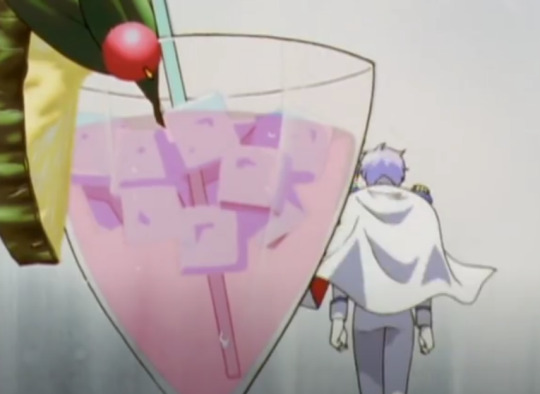
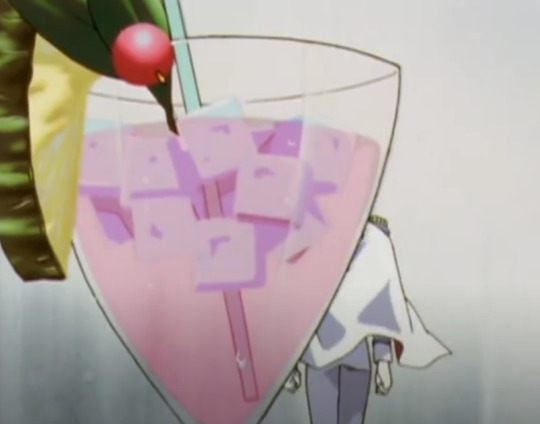
She puts her fist to the floor to lift herself up with the hand the ring is on. At no point does she "shatter the ring" as this person on Twitter tried to claim:

She has the intact ring still on for the rest of the episode. Because the ring represents her promise to free Anthy. You can watch the damn scenes yourself. The entire show is available on YouTube. I'd recommend watching the entire series first but here's the finale.
Wherever these painfully incorrect surface level readings of Utena are coming from please stop reading them and go to Ohtori.nu I beg.
69 notes
·
View notes
Text
GMMTV 2025
This year I had discussed two of my greatest peeves with GMMTV:
Lack of BL literacy and harrowing learning curve
Khujin paradox – it is their asset and liability
here & here
Having seen what GMMTV plans to offer in the year 2025, I have to admit that they might be on the right track.
Ticket To Heaven – I didn’t expect this. What percent of Thailand’s population is Christian? (Thailand has significant and influential Christian population.) Many frames and scenes in this one looks they were from the Japanese BL movie from 2007 Boys Love – School Boy Crush. Serendipitously, it is so similar to Jijo Kuriakose’s autobiographical queer film — Velipaadu (വെളിപ്പാട്) which also has seminarian main characters. But since the characters are Orthodox/Jacobite Christians but not Catholics there is additional compulsory heterosexuality.
Memoir of Rati – Most Beautiful Count colorism debacle has tarnished my love for Thai historical setting. This is one series where I really wish GMMTV did not stick to the nenja/wakashu style pairing. Yaoi revolution did not happen all those years ago for this to manifest in 2024-25. These aesthetic choices are something GMMTV and Change 2561 (among others) will learn to overcome. Eventually.
Me and Thee – I am not impressed by the choice of khujin for this role. The comedy is not working for me and I think that's probably because there is not enough gap moe between the actor playing the mafia boss and the mafia boss playing the actor. However, fans of this khujin might enjoy it immensely for the very reason. Love guru set up is underplayed, so I am expecting tonal shift half way through the series where the drama will play into the soap opera it is supposed be parodying. Some kidnapping and bloodshed maybe. Odo (royal road progression) is odo for a reason. Unintended consequence of the series was to remind me of my dearest wish to see unabridged version of Breath, the story of TulHin from Love By Chance 2) with shibari and all.
A Dog and a Plane - feels like a nice mix of Japanese BL Ossan’s Love: LOVE or DEAD and Ossan's Love: In the Sky and Cornered Mouse Dreams of Cheese. Since I thoroughly enjoyed both, I'm looking forward to this one. It also promises a lot of "wife-chasing" (My Stand-in's influence?) complete with a grand, lives-saving, heart-winning gesture.
Magic of Prophecy - Fortune telling as a reason for forced proximity in provincial Thailand seems nice but I'm afraid the series is going to go where The Sign went with superstitious local folks (as opposed to rational main characters, except it was a fantasy show hinging on those very local people's faith and festival) and gun violence. BL being a vehicle for Thaification is kind of inevitable but I wish it wasn't so and we would get more provincial shows like Love Poison. For a country that dared to give us Tropical Malady (2004) directed by Apichatpong Weerasethakul and Malila: The Farewell Flower (2017) directed by Anucha Boonyawatana (director of Not Me), their BL needs to do better.
Boys in Love - honor student x diliquent is a beloved pairing but this neurotypical honor student is not sitting well with me at the moment thanks to Iwashiro from Outsider Communication by Natsume Tsuno overwhelming my brain. But that is a me problem. The other pairs are cool and is in line with the saccharine sweetness GMMTV is known for.
Cat for Cash - this is for that khujin's fans as well as for cat lovers. Surrealist comedy with glittering, sputtering succulents in Love is Like A Poison has raised my tolerance for this brand of romantic dramedy.
Mu-Te-Luv - I am intrigued because it gives me the kind of feeling that I got when I watched the trailer for Hello Mummy. I wonder how Thai audience will receive this series' take on the non-romantic themes it deals with. So, I'm equally apprehensive and excited.
Love You Teacher - surprisingly it is Thailand that managed to get this show going. De-aging is a popular trope in BL and fan-fiction. Given the taboo nature of de-aging as a set up it is hard to pull off. But, if anyone can do that it is Thailand. This is resourceful side of khujin - they can't take the jado (evil road) narrative progression. No twisted moe. Yet, it leaves space for deception. Faking or automatic de-aging to cope with repressed stress and anxiety, like selective mutism and amnesia. It will be about character growth and unconditional love. Otherwise, the price GMMTV would have to pay would be too steep.
Melody of Secrets - wow, a dark take on amnesia trope! Seems like GMMTV finally figured out how to tease a jado progression within an odo plot - by employing a (faux)-look-alike so as not to upset khujin fans' worldview while offering them a thrilling experience. But it is clear that GMMTV won't be able top commit to a proper jado plot. That not their brand. It will not help with branding and advertising. There's no helping it. The violin scene reminded me of the Japanese BL with numerous adaptations Fujimi Orchestra. Also, the mind-forgot-but-body-remembers trope?!
My Romance Scammer - gold digging, getting ONESELF trapped in the love trap that one laid and marry-first-regret-later tied with the friction of getting a divorce. I want it to have first ever remarriage of the same pair in a live action BL.
That Summer - how does Thailand keep getting casting net wrong? At least it is better than diving with the net we're got in love sea. Prince? Who was assaulted? Found at a Thai beach? Reminds me of princess Latifa bint Mohammed Al Maktoum debacle.
Only Friends: Dream On - I like this set up more than the one for season 1. I wasn't happy about it and thought they could do better. I'm looking forward to this season. And for khujin fans, isn't it a good chance to enjoy netorare and stalking horse tropes since the Love Dodecahedron will anyway resolve into khujin pairings?
Burnout Syndrome - super pretty, shonen ai style art! Look at the nude he drew! Isn't it giving early BL vibes, from before the donkey dicks took over the BL manga scene thanks to Korea? Isn't it a beacon (please forgive the pun) of hope in the strange, new world of uncensored smut scenes in BL manhwa? Khujin's gonna khujin and stalking horse gonna stalking horse. I'm truly intrigued.
Head 2 Head - fine old wine, new bottle. Let's see if the wine (rivalry to romance, unrequited to required, college campus setting) can be as intoxicating when drunk from the new bottle.
Dare You To Death - Channel V style drama with khujin boarding together for reasons. Unfortunately, it did not moe for me. Maybe because I'm still trying to get over Zheng Bei x Jiang XiaoHai ship from The First Shot 雪迷宫 that paled in comparison to Zheng Bei x Gu YiRan ship. Honestly, I started watching just to listen to Huang Jingyu say heroin (hailouyin) and accidental got too invested in the cop x kingpin ship.
I wonder who suggested GMMTV to add so much of occult and fortune-telling in their series. Also, I am a little worried after seeing this post by @guzhufuren and this post by @alwaysthepessimist - there is opposition to BL in East Asian countries led by certain groups of feminists based on the disproportionate benefit accruing to men (especially actors, voice actors, creators and production companies' executives), declining presence of women in entertainment and advertising as well as shifting purchasing power from women to men through consumption of BL.
youtube
In this video, BL scholar Kim Hyojin talks about Boys Love in an Era of Feminism: Online Discourse on “Leaving BL” in Late 2010s Korea.
#gmmtv 2025#thai bl#gmmtv bl#gmmtv#bl 2025 line up#Dare You to Death#JongDunk#Boys in Love#Memoir of Rati#GreatInn#My Magic Prophecy#JimmySea#Me and Thee#PondPhuwin#A Dog and A Plane#TayNew#Cat for Cash#FirstKhao#That Summer#WinnySatang#Head 2 Head#SeaKeen#Ticket To Heaven#geminifourth#Burnout Syndrome#OffGun#Melody of Secrets#ForceBook#Only Friends Dream On#Dare You To Death
45 notes
·
View notes
Text

When you get publicly slapped by 4 surrealist poets because you insulted a guy's historical crush
(translation and context under the cut)
Gallantly Defending Robespierre’s Honour
In the conservative daily paper, Le Gaulois, on March 3, 1923, the journalist and man of letters, Wieland Mayr, expressed his pleasure: there would not be, he wrote, a "vile apotheosis" for "that holy scoundrel" Robespierre. On the other hand, Mathiez had the Surrealists with him. Following the article in Le Gaulois, Robert Desnos (1), accompanied by Paul Éluard (2), Max Ernst (3), and André Breton (4), summoned Mayr in a café and publicly slapped him for insulting the memory of "the Incorruptible."
Why did Mayr get Slapped?
In short: studying history in the 1920s was a messy business, especially when it came to the French Revolution….
To explain why Mayr ended up getting slapped, please allow me to briefly dive into the French Revolution's historiography during the late 19th and early 20th centuries. Keep in mind, that this is a grossly oversimplified version.
Before 1848, it was pretty standard for French republicans to proudly see themselves as inheritors of Robespierre’s legacy. (If you’ve ever wondered why in Les Misérables, Enjolras’ character is very much channeling Robespierre and Saint-Just, here’s your answer!) However, things start to change with the Second Republic.
In 1847, Jules Michelet brought back the negative portrayal of Robespierre as a tyrannical "priest" and leader of a new cult. This narrative helped fuel an increasing dislike for Robespierre, with radicals like Auguste Blanqui arguing that the real revolutionaries were the atheistic Hébertists, not the Robespierrists.
Jump to the Third Republic, and the negative sentiment towards Robespierre was only getting stronger, driven by voices like Hippolyte Taine, who painted Robespierre as a mediocre figure, overwhelmed by his role. This trend was politically motivated, aiming to reshape the Revolution's legacy to align with the Third Republic's secular values. Obviously, Robespierre, the "fanatic pontiff" of the Supreme Being, didn’t quite fit this revised narrative and was made out to be the villain. Alphonse Aulard (a historian willing to stretch the truth to make his point) continued pushing Danton as the face of secular republicanism. Albert Mathiez, one of Aulard’s students, was not having any of it and strongly disagreed with his mentor’s approach.
The general disdain for Robespierre began to shift after World War I. One reason was that people could better appreciate the actions of the Revolutionary Government after experiencing the repression during the war themselves. Albert Mathiez and his colleagues were actively working to change Robespierre's tarnished image. With tensions high, it's no wonder Mayr ended up being publicly slapped by a bunch of poets who were defending the Incorruptible's honour!
Notes
Robert Desnos (1900-1945) was a French poet deeply associated with the Surrealist movement, known for his revolutionary contributions to both poetry and resistance during World War II.
Paul Éluard (1895-1952) was a French poet and one of the founding members of the Surrealist movement, celebrated for his lyrical and passionate writings on love and liberty.
Max Ernst (1891-1976) was a German painter, sculptor, graphic artist, and poet, a pioneering figure in the Dada and Surrealist movements known for his inventive use of collage and exploration of the unconscious.
André Breton (1896-1966) was a French writer, poet, and anti-fascist, best known as the principal founder and leading theorist of Surrealism, promoting the liberation of the human mind.
Source: The text in the picture comes from Robespierre and the Social Republic by Albert Mathiez
90 notes
·
View notes
Text
Round 6 - FINALE
The winner takes all! Which piece of media deserves to be the Champion of 1997?

Revolutionary Girl Utena: If it cannot break its shell, the chick will die without ever being born. This sentiment, originally found in Hermann Hesse’s 1919 novel Demian, features during a repeated sequence in the 1997 anime Revolutionary Girl Utena. Hesse is far from the only reference to philosophical, surrealist, or heavily symbolic text in the show, which trades in visual metaphor and multi-layered subtext. Revolutionary Girl Utena follows the story of Utena Tenjou, a young orphan who aspires to princehood-- challenging or outright circumventing the place of gender in that aspiration-- and is entangled in a series of duels centered around a girl named Anthy Himemiya. Written by Kunihiko Ikuhara, Chiho Saito, and Yōji Enokido (known collectively as Be-Papas) and soundtracked by J.A. Seazer and Shinkichi Mitsumune, the show has an instantly recognizable style, combining lush fairytale visuals and French-inspired architecture with a choir that functions as a sort of Greek chorus to the internal worlds externalized in combat. Utena is a story about many things, arguably all things, taking a surgical scalpel to adolescence and using the flat of the blade as a paintbrush, leaving a deeply human, visceral work of art in its wake. It has been massively influential on feminist, queer & sapphic, and otherwise gender-deconstructive or gender-subversive modern media. Smash the world's shell! For the revolution of the world!
Radiohead's OK Computer: I go forwards, you go backwards, and somewhere we will meet. By the middle of the decade, Radiohead was weary of the ubiquity of their 1993 hit Creep; although the record that followed it (The Bends) was a lusher, more evolved album than their first, it had failed to produce a distinctive enough image for the band to undo what Creep had done. The song threatened to define the band entirely to those outside their devoted following. In 1997 the band swung for the fences with the haunting, abstract OK Computer. It was a move their label cast immense doubt on at the time, and its success then and now would cement Thom Yorke and his bandmates as soothsayers of a sort, draped not in bohemian silk robes but in white hospital sheets. It's an album that speaks to the future with dread more than wonder, that critics described as "nervous almost to the point of neurosis," but marries the uneasy experimental soundscapes with poetic, surrealist, and increasingly prophetic songwriting regarding the parallel lives we lead with technology. Featuring the singles Karma Police, Paranoid Android and No Surprises, OK Computer is hailed by many as the band's magnum opus: it's certified double Platinum in the US and five-times Platinum in the UK, and in 2014 it was included in the United States National Recording Registry as "culturally, historically, or aesthetically significant."
#revolutionary girl utena#shoujo kakumei utena#kunihiko ikuhara#radiohead#ok computer#thom yorke#1997
106 notes
·
View notes
Text
— ꣼ 𝑡ℎ𝑒 𝑡𝑎𝑙𝑒𝑠 𝑜𝑓 𝑡ℎ𝑒 𝑏𝑙𝑎𝑐𝑘 𝑎𝑛𝑑 𝑤ℎ𝑖𝑡𝑒 𝑠𝑤𝑎𝑛.

Kaeleena and Gaya can be seen as two faces of contemporary art, each representing a philosophy that matches their nature. Gaya describing herself as expressionism meanwhile she sees Kaeleena as surrealism. They are twins bound by blood, but in the end, they drift like night and day.


Kaeleena, the white swan, is driven by the desire to transcend reality, to dismantle the barriers of perception and reconstruct them into something entirely new. She aspires to a New World she will be the god of. Her works relies on transhumanism and the creation of a new species, something better than humans. Her connection to Surrealism is so far just an artistic preference, but it mirrors the revolution of thought. For her, art isn't as much of an escape than it is for Gaya but it can be an inspiration as she connects it to her science like Dali has. After all, surrealism is a tool to unlock the subconscious, to merge dreams and reality into one, the same way she does with her life work. The surrealist movement have these impossible juxtapositions and this boundless imagination and it works with her need to challenge the gods and to explore the depths, to go furthur than the simple human experience. To bend it to her will, too. She doesn't paint, it isn't how she expresses herself but if she did, her work would be filled with symbols, codes and narratives from an alternate dimension she wants to materialize as the future.
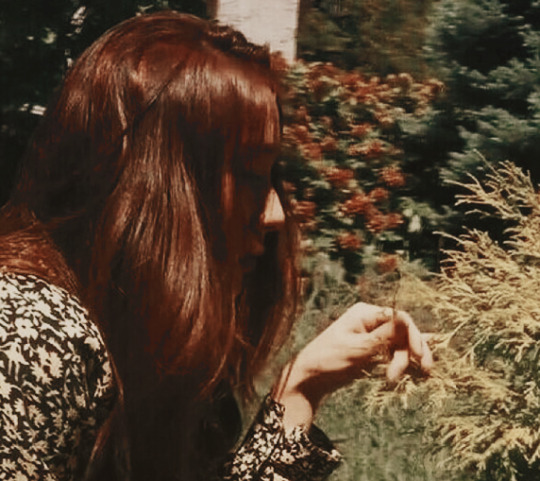

Gaya, the black swan, on the other hand, she is the visceral. If Kaeleena wants to revolutionize the human experience, Gaya is consumed by it, consumed by the heart more than the mind. She wears her emotions on her sleeve, she is emotionnally transparent and impulsive. She does paint and her art is inspired by expressionism, expressionism as a sub mouvement reflects her belief that art isn’t meant to represent the external world as it is, nor bend it like Kaeleena does, but to explore the emotions that world stirs. She says she can express with art what she believess words arent enough to embody. Gaya’s work is raw energy, with the force of her impulses, it sometimes also drifts towards abstract expressionism more. Where Kaeleena loves art to explore the surreal, Gaya uses it as a catharsis of her inner nightmares and memories. Every brushstroke, every color in her pieces seems to scream with feeling : anger, passion, sorrow, joy, all tangled together. Her art is then deeply personal, it appears she often paints the meadows of the House of Misericorde. Gaya has forgotten everything the human experiment that is the orphanage has put her through, brainwashed. Somehow, it's visible in her art even if she herself, cannot access the memories anymore. " A haunting vision of the meadows of Buckinghamshire, the landscape distorted yet still recognizable. The oil strokes are thick, deliberate, creating a scene that is simultaneously beautiful and unsettling. The warm tones of the meadow are interrupted by darker, more oppressive elements, as though shadows from her past have seeped into the painting itself. It is a reflection of her memories of the House of Misericorde, the orphanage where she spent her childhood. There’s something hidden in the strokes, a tension between warmth and sorrow, the weight of unspoken secrets craved in the fabric of the landscape. "
#꣼ 𝑘𝑎𝑒𝑙𝑒𝑒𝑛𝑎 𝑛𝑎𝑟𝑎 𝑘𝑎𝑛𝑔. / the white swan.#꣼ 𝑘𝑎𝑒𝑙𝑒𝑒𝑛𝑎 𝑛𝑎𝑟𝑎 𝑘𝑎𝑛𝑔. / headcanons.#꣼ 𝑔𝑎𝑦𝑎𝑛𝑒 𝑠𝑎𝑒𝑟𝑎 𝑘𝑎𝑛𝑔. / headcanons.#꣼ 𝑔𝑎𝑦𝑎𝑛𝑒 𝑠𝑎𝑒𝑟𝑎 𝑘𝑎𝑛𝑔. / the black swan.#꣼ 𝑡ℎ𝑒 𝑡𝑎𝑙𝑒𝑠 𝑜𝑓 𝑡ℎ𝑒 𝑏𝑙𝑎𝑐𝑘 𝑎𝑛𝑑 𝑤ℎ𝑖𝑡𝑒 𝑠𝑤𝑎𝑛.#Straight from what i wrote with C. @terragro#This has been inspiring
9 notes
·
View notes
Text

Photo: Max Ernst, "L’Ange du foyer (Le Triomphe du surréalisme)," 1937
* * * *
One hundred years ago, in 1924, André Breton published his Surrealist Manifesto, which advocated for a revolution against rational thought and its constraints. Breton’s definition was simple: “Psychic automatism in its pure state,” he wrote at the time, “by which one proposes to express—verbally, by means of the written word, or in any other manner—the actual functioning of thought.” But psychic automatism could function in many ways. Salvador Dalí, for example, made spare landscapes that looked irradiated, melting. Max Ernst waded into abstraction. René Magritte let symbols speak of a numbing sameness in many souls. And Giorgio de Chirico’s ghostly plazas are places of haunting loneliness. In this exhibition, which celebrates the movement’s centenary, works by the greatest Surrealists are on view. The centerpiece is the manifesto itself.
—Elena Clavarino for Air Mail
From the Centre Pompidou:
Designed like a maze, the “Surrealism” exhibition is an unprecedented dive into the exceptional creative effervescence of the Surrealist movement, born in 1924 with the publication of André Breton’s founding Manifesto.
Combining paintings, drawings, films, photographs and literary documents, the exhibition presents works by the movement’s iconic artists (Salvador Dalí, René Magritte, Giorgio de Chirico, Max Ernst, Joan Miró), as well as those by the female Surrealists (including Leonora Carrington, Ithell Colquhoun, Dora Maar).
The exhibition is organised both chronologically and thematically, structured into 14 sections that evoke the literary figures who inspired the movement (Lautréamont, Lewis Carroll, Sade, etc.) and the poetic principles that structure its imagery (the artist as a medium, dreams, the philosopher’s stone, the forest, etc.).
At the heart of the exhibition is a central “drum” housing the original manuscript of the Manifesto, an exceptional loan from the National Library of France. A multimedia screening accompanies the discovery of this unique document, providing insight into its creation and meaning.
[Follies of God]
[Centre Pompidou]
#Centre Pompidou#Follies of God#Elena Clavarino#Surrealism#Joan Miro#Salvador Dali#Rene Magritte#Max Ernst#about art
11 notes
·
View notes
Text
Deathless Thoughts:
I only read this book in full once in 2017 and have only really paged through it a lot since. I definitely found it much more deliberate and thematically coherent this time around. I remember initially feeling like the surrealism and constant jumps ahead were disjointed but it reads very cohesively to me now. I’m very curious if that will continue past the latter 50% which I haven’t reread yet. I remember starkly disliking that portion and I have no idea if I’ll feel similarly this time around— because I already enjoyed the second act much more on reread and acknowledged its purpose, when up until now I did not lol
My initial thoughts were that the fantasy elements were too surreal to care about and that the relationship was too much of a nothing, with too little not unpleasant screen time to justify its centrality to the plot. But having read more classic surrealist Russian lit has familiarized me to the former and makes me actually understand what it’s going for. And for the latter I think I’m just more onboard with unpleasantness and abuse being the point. So currently, my perspective is almost wholly positive.
I enjoy the book’s use of its subject material— fairytales set in actual history— as many many metaphors. First folktales and fantasy specifically in the Soviet era, so rife with censorship, as a vehicle for allegory, their use and importance in literature itself being a motif. Then the metaphor for inexorable class hierarchies and unchangeable power structures before and after the revolution, the way only the branding changed, but the power structures remained. And also, most pervasively, as a way to examine gender roles and gendered loss of agency; the politics of a marriage.
I really liked the way the novel built up Koschei and how everything is about Marya’s relationship with Koschei (her relationship with agency and the lack thereof) even when he’s fairly infrequently on screen. From her sister’s bird husbands in the opening, and child Marya’s musing on the potential transformative nature of marriage— but also the inherently unequal power dynamic and resolving that she will do/be better because she knows more than they did. To the metaphor of her thinking that a secret will treat her well and then later the line where the personified secret is then likened to a husband who will be her ruin. Even that when Koschei finally shows up to take her away it’s compared to being taken away by the revolutionary government/the police.
Marya is herself highlighted for her knowledge and her desire for it. Specifically the ability to see discrepancies in the stories she is told whether that is the magical or ideological and political. The sisters in the opening marry into seemingly static unmoving snapshots of history. Meanwhile Marya’s singled out in her precociousness and open admittance of there being anything completely beyond the ideologies presented by each suitor in his human form [the power structure of the Tsarist state, and the Soviet Union]. She’s defined by wanting to see beyond dichotomies and limited scopes of propaganda. She sees it as a skill, and it is, but it’s also something that singles her out for misery, both by her peers (the scarf incident) and by the likes of Koschei who is specifically drawn to willfulness and a lack of adherence to a particular role with the intent of breaking that will.
The entire seduction segment that is turning all the food and her illness into an erotic power exchange is also just explicitly about breaking her will, and fostering perfect obedience and dependence on him. It’s also really interesting that, in going with him, she does somewhat lucidly give up and trade away her agency/ability to dictate a story/her own perspective in exchange for being physically well cared for. (But then even that is very thorny and with many strings attached)
So by part two, she is stuck in the dichotomy of “who is to rule” and either she can be a Yelena/Vasalisa or a soon-to-be Baba Yaga. Yet, either way, she is never good enough and it is still inevitably an exploitative and draining situation.
Marya being successful in her willingness to do degrading and cruel things to earn Baba Yaga’s blessing and Koschei’s favor being punctuated by all her friends— who without which she would never have succeeded at all— dying horribly illustrates that so well. In her success she is only further isolated. She will never repay their help, because being Tsaritsa of Buyan, and having any sort of power, is inherently antithetical to that.
The emphasis on Lebedeva’s girlboss magic makeup and the passage about Marya being told that girls must care only for vapid, pretty things, among other moments, might feel extremely dated. But I do think they’re intended to be employed in a way where traditional femininity presents a sort of deliberate and acknowledged safety? And it goes hand in hand with Marya, while never choosing to be a “Yelena” in traditional soft femininity, does end up choosing to try to leverage soft power and soft manipulation within deliberately gendered terms fairly often. But again it’s just presented from a very dated and particular context.
So far, the sheer dedication of the book to being an explicit Bluebeard tale and a story about abuse, and how there is no winning in that sort of relationship has been very fun for me.
I also enjoyed Koschei outright lying about the Yelenas and Vasalisas— and then later about the location of his death. I think that’s a character type you usually expect to deceive via omission but, no, he just outright lies a lot.
Another example is that Widow Likho’s book makes it clear that humans best enter into Buyan when ill, and meanwhile everything Koschei does is of course explicitly a repetition of previous stories. So it’s practically confirmed that he had taken every Yelena etc on that same long trip and made them ill on purpose. Even though in the moment he claims to be surprised by it, and spontaneous in caring for her through her illness.
Or the suggestion that he found a reason to put all the other girls in the stable when they got to Buyan as punishment for disobeying him. That the point is the punishment and breaking of the will rather than there being any sort of standard the bride could realistically meet where he would be happy with her and welcome her to her new home without that initial humiliation and fear.
It’s also incredibly funny and refreshing that this book buys into Koschei’s nonsense way less than any of its subsequent imitators. (The Grisha trilogy included!) I enjoyed Baba Yaga being like “Why is everything black, stop being dramatic 🙄”
He’s barely present in the book at all. His page count is truly negligible! And it’s great!
Like I mention earlier, that was actually something I was annoyed by on my first read, the relationship just seemed fairly thin, even though the snapshots of it that we get are fascinating. But after being inundated with so many books worshipping the ground love interests like him stand on, I love how much he doesn’t fucking matter and how little page time he has. How that itself allows Marya’s emotions and conflicted feelings to remain central. The narrative doesn’t care about him, it’s only what impact he has on her that’s relevant.
Anyway somewhat superficial but I really enjoy the goth love interest being the Tsar of Life, because authors typically go a more obvious and melodramatic route. Despite all of the goth mystique, him not being associated with death, darkness, night, etc was refreshing. But also I do generally just find the concept of life being equated with the lurid and demanding, the parasitical, something that is always in a personal sense at war with death— aka the mention of him always looking sickly or feeling skeletal initially when he kisses Marya— a compelling one. It’s death and the maiden wrapped up in a single person essentially.
Anyway I also appreciated the parallel of the Yelenas being trapped in eternity weaving soldiers while Marya’s first thought upon seeing Koschei is that if she had knitted herself a perfect lover he would look like that. There is the constant underpinning of Marya being wholly separate from them, the question of whether she is greater or more horrible than them, but at the heart of it she’s really not. She’s just another victim in a long string of them.
#cautiously hopeful that I’ll like the second half just as much despite my opinions on first read#deathless#koschei the deathless#marya morevna#book talk#*writer’s cap*#dark stories of the north
37 notes
·
View notes
Note
btw at le mans 2013 some vale fans had a huge (cringey ofc) banner which went like
yzr-m1: someday my prince will come
vale badly photoshoped as a prince: sorry babe
here’s how we can tie this to rgu and the whole prince&princess theme
also remember how in rgu the movie utena turns into a car and all? well what if valentino had some weird (vaguely erotic) dreams in that vein…….

(x, x) kermit at that poster not at the ask, to be clear!! weird ass sport
anyway, let's talk more about how to apply surrealist anime rgu to motogp! and yes, again, we are kinda stripping rgu from a lot of the stuff it was Actually About, but y'know on the other hand it'd also be flattening that particular artwork if your stance is that the 'only' things the story is relevant to is like. cycles of abuse. structural patriarchy. on-screen depictions of sibling relationships designed to make you extremely uncomfortable. all that stuff. so we are taking it as read for the rest of this post that rgu deals with more serious stuff than competitive sports and work from there
the car stuff!! anthy's prince literally turns into a vehicle to allow her to escape! it ends with both of them like... intertwined on the remaining husk of that vehicle, riding off into freedom. also the car looks cool
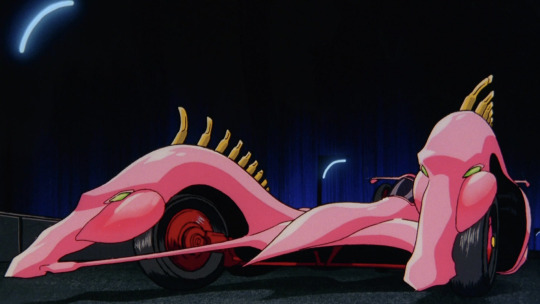
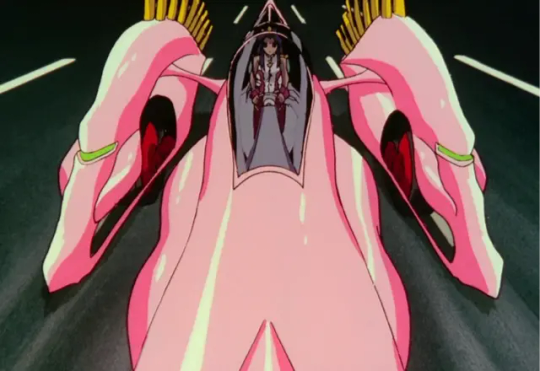
this isn't super relevant, I was just thinking about how much fun they made that car. like they made sidepod-wings into horsies. eat your heart out, ducati
now, in the film this is basically a metaphor for growing up, right. anthy is finally breaking out of the school and embracing her revolution by quite literally freeing herself from the prison she had both been entrapped in and had continued to entrap herself in. and isn't that... isn't that basically what valentino is doing when he's leaving honda for yamaha. well, no, obviously it's nothing like that. but say that it was like that, and that essentially this is the process of growing up, coming of age, growing into his own or whatever you want to call it. self-actualisation. a spiritual journey to a different bike manufacturer. valentino does think he's like... imprisoned in honda, it's his whole theme that year, he does a cute callback when he's won the title. brno 2003 is both the prisoner celebration and where he signs for yamaha, like he's not really being subtle about this. and the only way he can fully become himself is standing on his own two feet, thrive or fail, at yamaha. because now he's no longer following the path that's been set out for him. honda was comfortable in many ways, it was a very pretty prison - even if he felt underappreciated, he was still the golden boy at The Most Successful Manufacturer, he'd inherited doohan's team, he was building up a dynasty of his own. he was leaving behind basically... a completely guaranteed title for 2004 and most likely years beyond that for something far less secure
there is a kinda. obvious point here. and it's that according to this framing, valentino is implicitly being cast in the role of the princess. and the bike is the prince, who is being ridden to safety. which fits into the idea that there's like,, a deeply possessive element, of the bike towards the rider, and that's basically the key prince trait beyond lip service commitment to 'nobility'. I think that does kinda... work, not just because the contrast with the expected gender roles makes it more interesting, but also because 'seeing a vehicle as a symbol of liberation' inherently feels like a very valentino thing. the thing about anthy is that it's always a bit unclear how much power she has over what's happening, but when you rewatch the show enough times you do increasingly go 'huh has she been psychologically tormenting all of these characters for over thirty episodes as a diversion from the horrors of existence'. and the film very much then becomes... her version of events, if you will, where her brother the devil (that guy sure keeps cropping up in these asks) has become this defanged parody of himself,, and it really becomes more about her using utena to make the final step. or something!! obviously this is only one interpretation etc etc. but idk I think there's a fun element of this dual role of 'princess' and 'witch' where you've got a character who increasingly exerts autonomy over their own narrative and plays god a little bit and can also force other characters into slightly sadistic mini-arcs where they get turned into cows and who eventually brute forces their own vision on the world. because they do have power, and they are the instigator of the entire plot
so. so. I think one of my favourite things about valentino is... okay, so I don't actually really like when athletes are that good. with both valentino and marc, I have a very begrudging attitude towards just how successful they are, because that level of dominance is extremely 'meh' to me as a sports fan. they're really the exception here as far as I'm concerned, I'm very tenuously okay with their title count but it is also A Bit Much. but the thing about valentino, right, is that he mostly gets around that bit of my brain by also seemingly have a bit of an issue with dominance. the way he progressed through the ranks to the premier class is like,, nowadays, doesn't even stand out as notable because that's Just How Feeder Series Work, but back then it wasn't as guaranteed because they weren't feeder series!! it's not necessarily like clearing a level... you can just stick around to win more than one of these titles, and valentino was seriously considering doing as much but decided to move up anyway. I think there's something fun about how he kinda needs a certain difficulty level to get his brain into it. he's flirting with depression after 2002, writing in his autobiography about how AWFUL it is that winning isn't FUN any more, does his insane little yamaha switch which somehow worked out for him, got really into his f1 flirtations until quite literally when he starts losing again... he needs a bit of drama, he needs enemies, he needs MEANING!! I think inherently he's very suited to any role that casts him as a quasi-malicious storyteller, especially one that's searching for like,, some kind of Growth and progression. and also playthings. which then regularly feeds into a set of callous behaviours towards The Competition when it's seen as necessary. or just satisfying
the way this works when you. y'know. personify the bike into the prince,, is that inherently the prince's pov on this is also quite selfish, right, like it's a saviour complex and thinking you are The One who can claim the princess as your own. the prince can keep the princess safe... who can be used by the princess/witch as a tool to bring about world revolution, and so on. the prince attempts to control the princess, and the princess is devoted to the prince. and also, they can make each other worse!! it's kind of... eventually as a duo they can become so dedicated to this sick game they're playing that basically any act is excusable as long as it helps them win. anyway crucially I do think if you did a surrealism on valentino's brain, some blue haired girl personification of the m1 rocking up to save him from his shackles and allow him to finally attain revolution by turning into a vehicle and literally carrying him to safety... does sound about right, yeah. weird erotic bike fantasies and all
#batsplat responds#brr brr#//#turning this around in my head i'm not sure i quite Got to where my thoughts on this are yet#but u can't overthink these things#honestly i was initially more on the 'valentino rocking up with the sex car from the show' track#but valentino as the princess riding the prince to freedom is kinda!! idk it feels right. send in feedback#//st
6 notes
·
View notes
Text
i wanted to share something really cool i found yesterday... robot doggy research as per usual. because of the nature of another project im working on ive been thinking sabout collecting some "side data" and trying to create a kind of timeline or archive of "secondary interpretations" of robot dogs: not a timeline of their creations, but a timeline of works representing/interpreting them (songs, literature, visual arts). and i think i found my earliest one , so far!!!
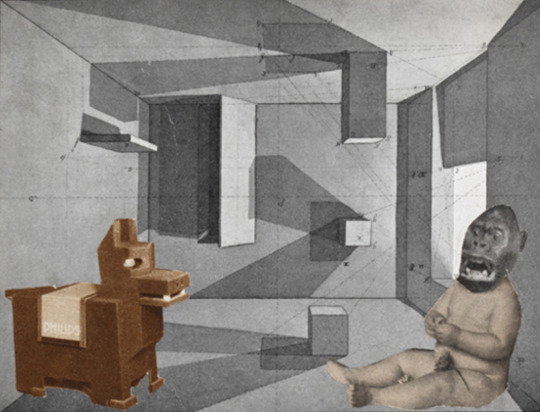
this is from a collage found in a sketchbook released by the breton estate in 2003. this book featured 33 collages done in collaboration between surrealist artists andré breton, paul éluard and suzanne muzard. the notebooks were bought by the ubu gallery and displayed in 2012. (check out the collection here!!!)
notice that figure on the left.... that's the philidog, (potentially) the earliest iteration of the robotic dog*!! the philidog was designed and created and had multiple iterations that spanned from 1928-29 iirc. this collage is dated roughly to 1931!!!!!
some more gushing and personal research thoughts down below but besides the actual designing and making of the philidog, methinks this could be one of the first examples of the "second round of interpretation" when it comes to the robot dog. ...in simpler terms, the first art made of robot dog. How exciting!!!!!!!!!
in terms of main research im doing rn wrt emotive qualities of objects and the understandings/interpretations of this post-industrial revolution/mass productions... in seeing the documentation of peoples platonic/romantic/sexual fondness of these objects, this piece really sticks out to me. i'd like to look at it a bit closer before "finalizing" any thoughts on it but this is really so striking to me. in this research my earliest source-anchors are from 1909, but then the next one brings us to the 70's...
*a lot of my research is also about defining the robot dog on a level beyond the intention of dog-like form, so this is in the air. however, it seems like the philidog is the first *intentional* mechanized dog-thing
10 notes
·
View notes